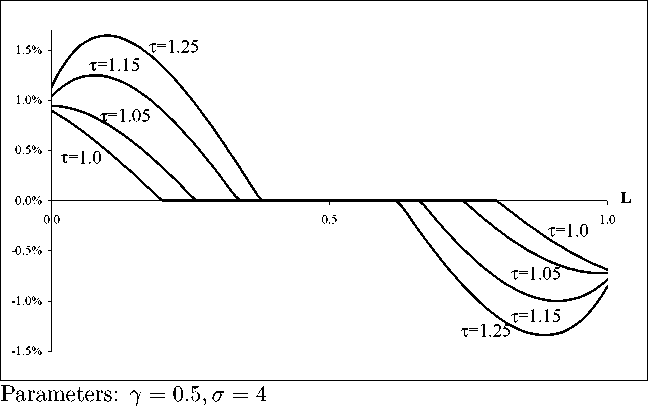respective loosing region. Denoting by YCN and YCN* the real income at
the Nash-equilibrium without cooperation and by YRC (R) and YCC*(R) the
real income under cooperation for given transfers, the necessary amount of
transfers can be derived as follows:
YRC(R) -YRN =0, if YRC(0) >YRN,
YRC*(R) -YRN* =0, if YRC*(0) >YRN*, (18)
R = 0 , otherwise.
Figure 4 display the necessary transfers according to (18) guaranteeing
each region to reach at minimum the welfare level of the no-cooperation case.
Two important results can be derived from this figure. First, if regions are
not too dissimilar, both gain from cooperation and compensating transfers
are unnecessary. Furthermore, this range widens if trade costs decrease and
integration proceeds. Second, even at full integration with zero trade costs
(τ =0) transfers to much less developed regions must be granted.

Figure 4: Necessary transfers under cooperation avoiding welfare losses
Altogether, transfers are an appropriate policy to reach the goal of max-
imizing aggregated welfare while simultaneously the welfare loosing regions
are compensated for their loss. Concerning less developed regions this result
implies that joining a customs union may be useful from a welfare point of
view only if appropriate transfers are granted by the richer regions.
15
More intriguing information
1. Markets for Influence2. Graphical Data Representation in Bankruptcy Analysis
3. Equity Markets and Economic Development: What Do We Know
4. What Contribution Can Residential Field Courses Make to the Education of 11-14 Year-olds?
5. The name is absent
6. Improving the Impact of Market Reform on Agricultural Productivity in Africa: How Institutional Design Makes a Difference
7. The name is absent
8. Individual tradable permit market and traffic congestion: An experimental study
9. The name is absent
10. Confusion and Reinforcement Learning in Experimental Public Goods Games